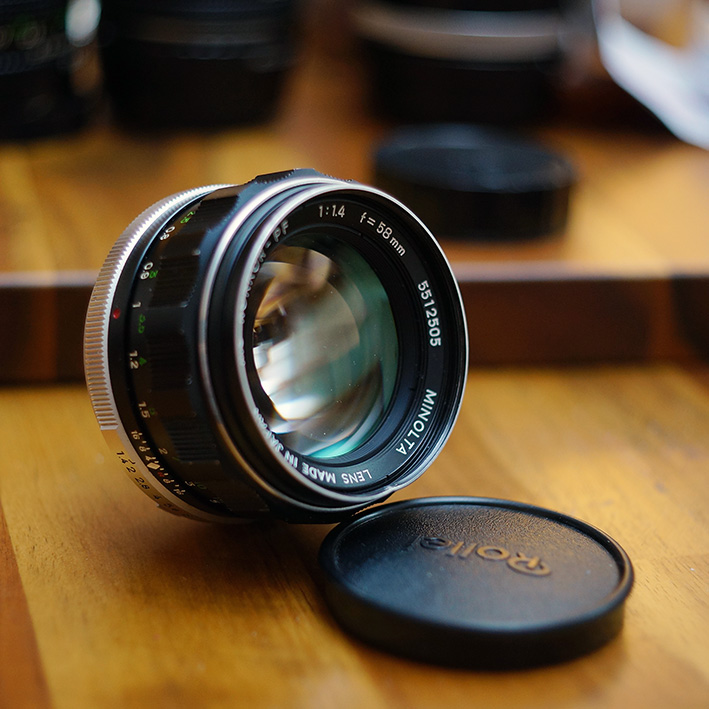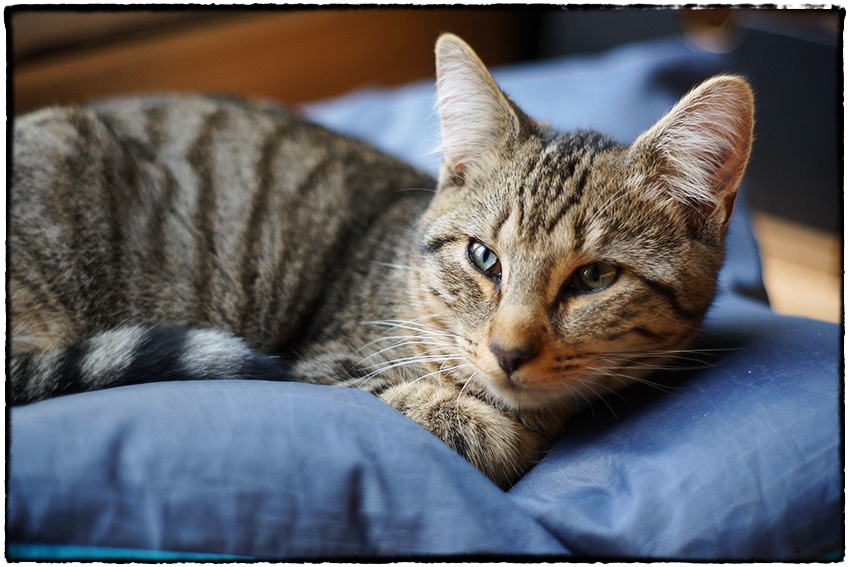I’ve been collecting Minolta Rokkor lenses lately. I’m adapting them on a NEX camera, with the cheapest Chinese made adapter I could find.
50mm lenses come in various flavors, and are affectionately called “nifties” (from Nifty Fifty). Used on 24×36 film cameras they were considered “normal” lenses as they offered a field of view very close to that of the unstrained human eye. Used on modern APS-C “cropped” digital sensors like that of the NEX cameras, they become short telephoto lenses, particularly well suited to portraiture.
Minolta Rokkor lenses exist in many different focal lengthes and types, fixed (“primes”), zooms, macros. Doing mainly portraits I have concentrated my choice on various 50 options, which I’m going to talk about now. I will describe as faithfully as I can the specific versions I am using, with picture of the lens themselves, followed by samples and a bit of rambling. A important side note : all the following reports come from strictly personal observations. I am in no way an expert, or have authority regarding those lenses. Sample variation is a fairly real component of gear assessment. So keep in mind what I have to say about any particular version, while true for MY copy, might not be perfectly accurate for yours. However, having collected 3 different units of the MD 50/1.7 (in two different versions), the IQ of all three has proven 99% identical.
Now that all the necessary foreword and warnings have been dealt with, let’s get to the meaty part.
Here’s the cast of characters, my Rokkor lenses as follow, from left to right :
MC Rokkor PF 58/1.4, MC Rokkor PG 50/1.4, MD Rokkor 50/1.7, Minolta MD 50/1.7. All lenses are labelled “Made in Japan”, or “Japan” only in the case of the smaller, most recent and lighter MD lens, also the only one not wearing the “Rokkor” name. Both 1.4 lenses are really heavier, obviously metal, the 58 even even has a metal focus ring, as opposed to the 50’s rubber ring.
This is the latest addition to my collection. I’m a little *less* pleased with it than I am with my other Rokkors. I’m finding that it’s really a bit longish for indoor portraits, as the very tight framing of the following shot goes to prove :
It also seems not quite as sharp as the 50/1.4, though this is to be taken with a grain of salt, considering this shot has received NO sharpening whatsoever in PP. There was, however, a bit of contrast added.
For instance, the lesser sharpness of this sample shot is most likely due to unperfect focus. One really has to remember how thin DOF is on those lenses at fast apertures (here F2). Miss critical focus by a hair, and the whole perception of sharpness is altered. What you can see here, however, is the excellent color reproduction, contrast, and smoothess of OOF (out of focus) areas, none of which have been changed in any way (NO pp at all on the Cinderella series).
On my copy the aperture ring is a tad stiff, clicking a bit more firmly than I’d ideally like, and the focus ring, while very nicely dampened, is not quite as free as that of my other Rokkors. It is still very smooth and nice to operate, but the others’ are superior in handling.
The star : MC 50/1.4 PG. Best of my herd.
This lens has it all. My particular copy has a dented filter ring (though totally functionnal) and it cosmetically its bears its age, albeit graciously. The aperture ring clicks in a definite way, with none of the amazing dampening of the focus ring. Focusing is like moving pieces in heavy butter. Ultimately smooth. This makes manual focus extremely pleasurable and very fine, very precise.
@F2, a very typical shot of the amazing sharpness, clarity, beautiful color and contrast, and bokeh of this lens. Wide open (1.4) is has a very specific “glow” and softness of edges, which can be interesting in some cases.
A really cool attribute of this lens is the lovely balance between great sharpness and smooth backgrounds, with very pleasing transition.
El cheapo. Minolta 50 F:1.7 MD “Japan”. No “Rokkor” here.
From what I understand this lens is the latest version and was produced circa 1981. I had two copies of this lens, a perfectly mint one I sold, and the one pictured above, that’ll probably stay with me forever since it has a small piece of mold between the glass elements. I affectionately call it “the fungus lens”. I’m not saddened in the least this lens is not fit for sale. For some unknown reason it performs way better than its specifications, and its specific issue, lends to believe.
It boggles my mind a bit than a flawed, 40$ lens, can deliver THIS well.
 One annoying thing on the F:1.7 versions, is the lack of stop between 1.7 and 2.8. F2 would have been perfect, but to achieve that you’ll have to manually sort of gently set the aperture ring in between those two stops, and just hope it won’t get knocked back to either fixed setting when you handle the focus ring. Which I did for this shot.
One annoying thing on the F:1.7 versions, is the lack of stop between 1.7 and 2.8. F2 would have been perfect, but to achieve that you’ll have to manually sort of gently set the aperture ring in between those two stops, and just hope it won’t get knocked back to either fixed setting when you handle the focus ring. Which I did for this shot.
Color (though you can’t judge that here) and contrast are this lens’ strong suit. Bokeh is a little nervous, a little busy, but personally it doesn’t bother me.
The lens is smaller and lighter than all its cousins, with a 49mm filter. It handles beautifully, with definite clicks of the aperture ring, and wonderful dampening of the focus ring. Though the lens is mainly plastic, it offers an extremely pleasurable shooting experience, much better, for instance, than an equally plastic (and optically even superior, Canon FD 50/1.8).
Because I love my cheapo 50/1.7 so much (I often can’t decide whether to mount it or the 1.4 PG on the camera !), and because of an ever slight softness at 1.7, I started researching the other versions of that lens. Some web based info seemed to indicate than some Rokkor fans were preferring the earlier MD version, with 55mm filter ring. This lens, branded “Rokkor X” on the US market, retains a mostly metallic construction from the previous iterration, but already has the improved modern coating of the next generation. It looks like this :
 Thinner focus ring, wider diameter, heavier, green vs. orange marking.
Thinner focus ring, wider diameter, heavier, green vs. orange marking.
What can I say ? Super smooth focusing, great IQ. Just lovely.
Here again, I “tried” to have the aperture set around 2. The aperture ring tends to be knocked back to either 1.7 or 2.8 more easily than on the cheapo plastic lens, which makes me want to use the latter more, though sharpness might be a TAD better with the metal lens (if you look with a microscope, that is…)
 Again, the strong suit of the Rokkor lenses : great balance between sharpness and smoothness.
Again, the strong suit of the Rokkor lenses : great balance between sharpness and smoothness.
So, what do I make of all this ?? The 58 is my least loved. 55 is my favorite focal length for indoor portraits. When you don’t have that much backing space, a few mm do make a difference, and I find this one just a tad long for comfort (reason why I shot the Helios 58/2 once… and put it back in the lens cabinet). My copy’s focusing ring isn’t quite on par in dampening and “butterness” with my other Rokkors. Will probably return it, since I can.
50/1.4 PG is the sh$t. There’s nothing not to love in that lens, except I’d like to have a more minty copy, but that’s just being spoiled here…
Plastic MD 1.7 with 49mm is way better than it has any legitimate right to. My copy having a little fungus inside, and since I got it dirt cheap, makes it even more ridiculously good. It is softer wide open than the Canon FD/1.8 or Rollei 1.8 Planar (both deadly sharp wide open), but if you manage to sneak the aperture to F2, it sharpens immediately, and the contrast and color and just *perfect*. A lot of 3D pop and presence in this lens. A sleeper.
The more metallic “X” version (though my own copy isn’t branded X since it doesn’t come from the US market) is bigger, heavier, and just as good. It’s just not noticeably better (but maybe unnoticeably so, which is becoming a little esoteric, lol).
The final word is that all the Rokkors I’ve been able to shoot are delightful lenses, offering tremendous value, considering the usually reasonable prices they commend in either the US or European used market.




















When you mount these old Minolta lens to a NEX body through an adapter, what is their 35 mm equivalent focal length? For example, if I mount a Minolta “50 mm” lens, what would the resulting 35 mm equivalent focal length be? Great informative post, thanks!
For a legacy lens such as the Minoltas attached to an APS-C sensor camera like the NEX (or Fuji) have a 1.5x multiplier so a fast 50 like the lenses in the article have a FOV that is equivalent to a 75mm on a 35mm film camera. The New Sony Alpha cameras (7 and 7r) are full frame so legacy lens has the same FOV that they would on 35mm film.